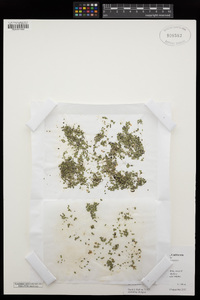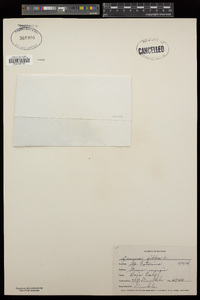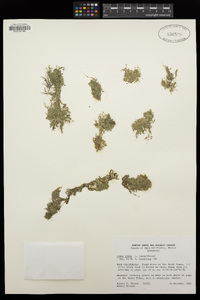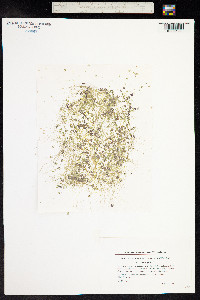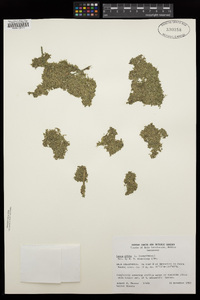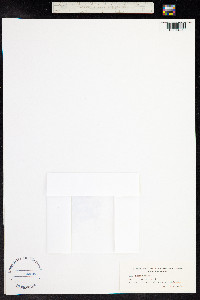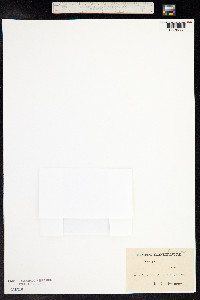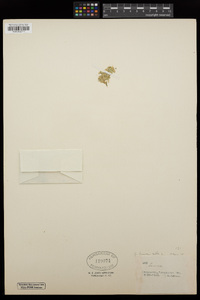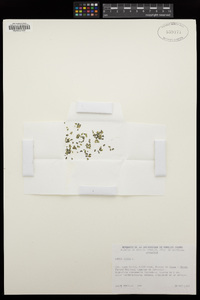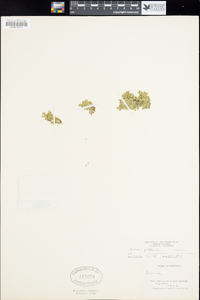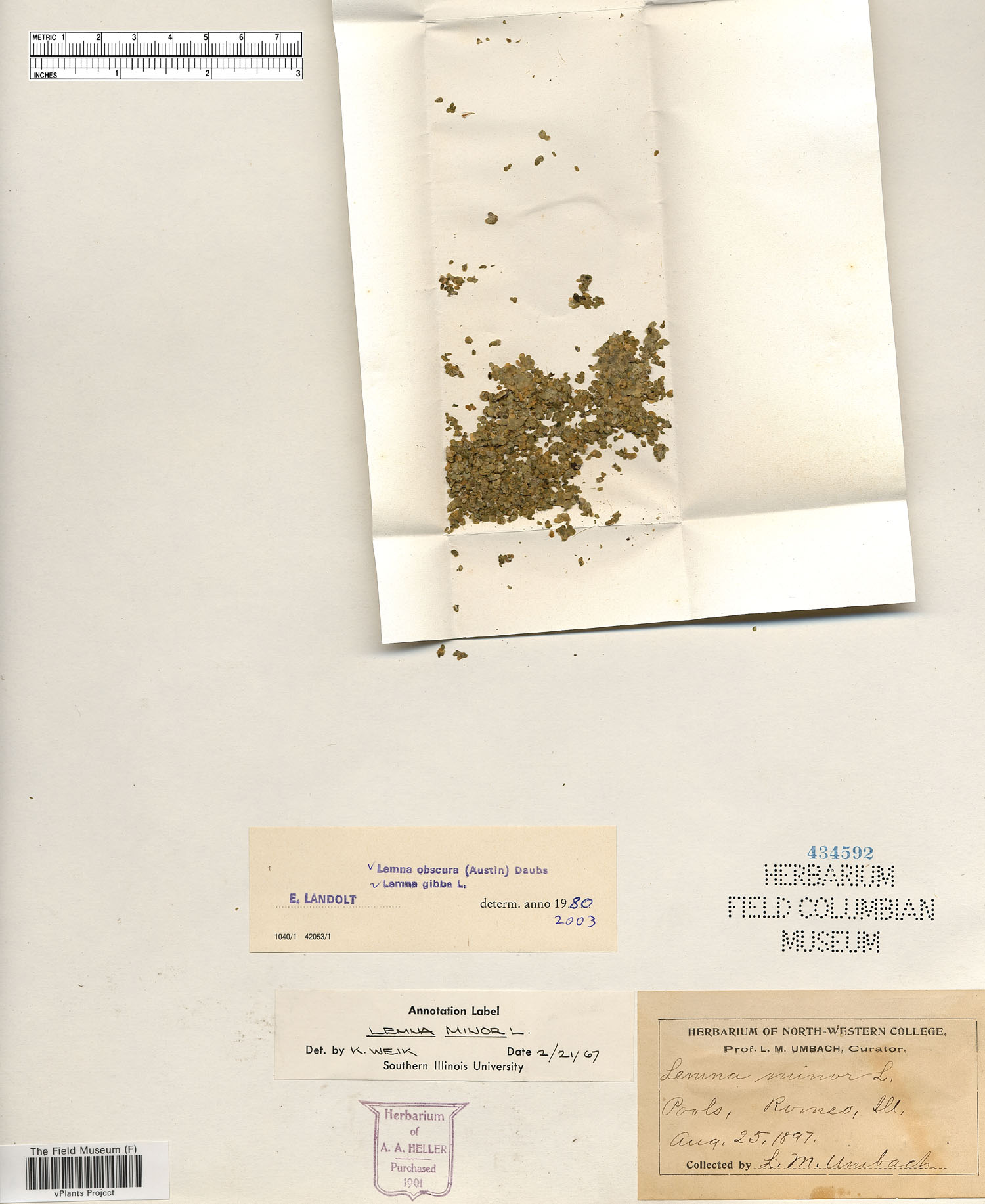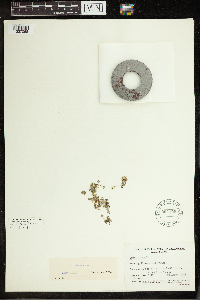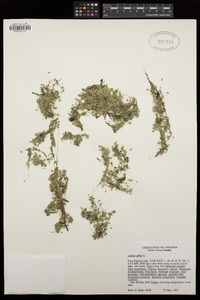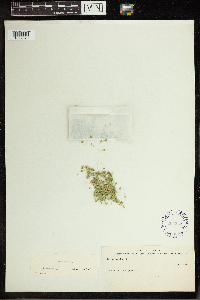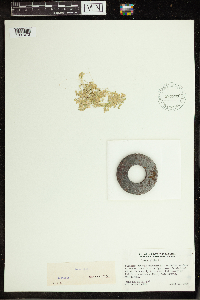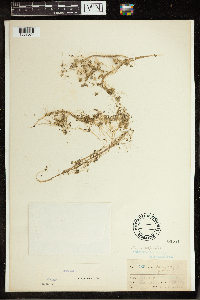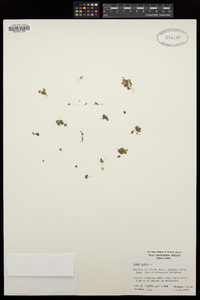Lemna gibba
|
|
|
|
Family: Araceae
Inflated Duckweed
[Lenticula gibbosa P. Renault, moreTelmatophace arrhiza Schur, Telmatophace generalis E.H. L. Krause, Telmatophace gibbosa (P. Renault) Montandon] |
Roots to 15 cm, tip mostly rounded; sheath not winged. Stipes white, thin, often decaying. Fronds floating, 1 or 2--5 or more, coherent in groups, obovate, often gibbous, 1--8 mm, 1--1.5 times as long as wide, margins entire; veins (3--)4--5(--7) (all originating from node), greatest distance between lateral veins near or distal to middle; papillae often indistinct; upper lower surface sometimes red colored, coloring beginning from margin, lower upper surface occasionally with distinct red spots beginning from margins near apex; largest air spaces longer than 0.3 mm; distinct turions absent. Flowers: ovaries (1--)2--7-ovulate, utricular scale with narrow opening at apex. Fruits 0.6--1 mm, laterally winged. Seeds with 8--16 distinct ribs, falling out of fruit wall after ripening. 2n = 40, 42, 44, 50. Flowering (rather frequent) spring--fall. Eutrophic, quiet waters in temperate regions with mild winters; 0--1900 m; Ariz., Calif., Ill., Nebr., Nev., N.Mex., Tex., Wyo.; northern Mexico; South America; Eurasia; Africa; Atlantic Islands. Plant: Floating aquatic plant Leaves: FRONDS floating on the surface of the water, single or 2 to a few cohering in small groups, obovate, 1-8 mm long, 1-1.5 times as long as wide, often gibbous, without a green stalk but with a very small white stipe that often decays; margins entire; nerves (3-)4-5(-7), the greatest distance between the laterals near or above the middle; distinct papillae absent; upper surface occasionally with distinct red spots; lower surface sometimes red colored, the red coloring beginning from the margins; largest air spaces wider than 0.3 mm; the sheath unwinged, the tips mostly rounded; no distinct turions present Flowers: frequent, 1-7-ovulate, the small utricular scale with a narrow opening at the top Fruit: 0.6-1.0 mm long, laterally winged, with dry pericarp. SEEDS: with 8-16 distinct ribs Misc: -Eutrophic, quiet waters; below 1800 m (6000 ft); Mar-Sep Notes: root up to 15 cm long REFERENCES: Landolt, Elias. 1992. Lemnaceae. Ariz.-Nev. Acad. Sci. 26(1)2. Aquatic herb Flowers: occurring fairly frequently, lacking sepals and petals, with two stamens, surrounded by a membranous scale with a narrow opening at the tip. Fruit: bladder-like (utricle), thin-walled, 0.6 - 1 mm long, lateral wings present, with seeds having eight to sixteen distinct ribs and separating from fruit wall when ripe. Roots: to 15 cm long, tip rounded in hydrated specimens but pointed in dry specimens, root sheath lacking wings. Plant body: not differentiated into stem and leaves, floating or near surface, one to five or more attached, green sometimes with red spots above, often reddish beneath with color starting at margin, 1- 8 mm long, one to one and a half times as long as wide, often swollen to 4 mm thick on one side, circular to inversely egg-shaped, usually with four to five veins, with an indistinct projection. The air spaces inside the plant body are longer than 0.3 mm. Similar species: Other species of Lemna have plant bodies with fewer than 4 veins, air spaces smaller than 3 mm wide, and red color (if present) beginning at the root attachment rather than the margin. Flowering: late June to early September Habitat and ecology: Occasional in quiet waters of the Joliet area, much more common in the western United States. Occurence in the Chicago region: native Notes: This species is grown as a vegetable in Israel. Etymology: Lemna is the Greek name for a water weed. Gibba means "swollen on one side." Author: The Morton Arboretum FNA 2000, Cronquist et al. 1977, Kearney and Peebles 1969 Duration: Perennial Nativity: Native Lifeform: Forb/Herb General: Perennial, free-floating aquatic herb with roots to 15 cm; fronds solitary or cohering in colonies of 2-4, the stipes connecting them white, thin and often decaying. Leaves: Fronds (structures that look like leaves but are developmentally both stem and leaf tissue) tiny, floating, obovate to orbicular, often gibbous, 3-6 mm long by 2-5 mm wide, the apex asymmetrical, upper surface mottled yellowish-green, the lower surface often reddish purple, with 3-7 veins, these difficult to see even under magnification. Air spaces present, the largest longer than 0.3 mm. Flowers: Unisexual, with 1 pistillate and 2 staminate flowers enclosed in a membranous sheath in a marginal cleft of the frond. Fruits: Follicles, laterally winged, 0.5-1 mm, with 1-3 seeds, these with 8--16 distinct ribs, falling out of fruit wall after ripening. Ecology: Found in still waters and slow moving streams in areas with mild winters below 6,500 ft (1981 m); flowers June-September. Distribution: CA, NV, AZ, and NM; disjunct in WY, NE, TX, and IL; south to S. Amer.; also in Africa, Asia and Europe. Notes: Lemna is a genus of tiny, free-floating aquatic plants, which usually form loose mats or clusters of very small (ca. 2-3 mm) -leaves- that float on the water surface, with trailing roots that are thin, transparent, and not attached to the ground. L. gibba is distinguished from other Lemma spp. by having 3-5(7) veins on the leaves and roots greater than 3 cm long; it is separated from L. minor by the red color on the lower surface of the leaves, which begins along the margin. Identification of species within this genus is tricky and requires high magnification and technical knowledge of the group. To analyze anatomic structures (e.g., number of veins or extension of air spaces), transparent slides are necessary. Ethnobotany: Unknown Etymology: Lemna is from the Greek limnos, lake or swamp, while gibba means swollen on one side. Synonyms: None Editor: SBuckley 2010, FSCoburn 2015, AHazelton 2015 Thallus orbicular to obovate, 3-6 mm, nearly symmetrical, solitary or often in groups of 2-4, very often anthocyanic beneath, mottled yellow-green above, or anthocyanic on both sides, ±evidently 3-5-nerved, usually gibbous, the upper surface flat or nearly so and with ±prominent papillae, the lower usually strongly bulged, the tissue with larger and more prominent air-spaces than in no. 3 [Lemna minor L.]; spathe sac-like, open only at the top; fr narrowly winged; seeds (1)2-3(-6), distinctly many- ribbed; 2n=40, 50, 70, 80. Nearly cosmop., but rare and irregular with us. Gleason, Henry A. & Cronquist, Arthur J. 1991. Manual of vascular plants of northeastern United States and adjacent Canada. lxxv + 910 pp. ©The New York Botanical Garden. All rights reserved. Used by permission. From Flora of Indiana (1940) by Charles C. Deam Indiana Coefficient of Conservatism: C = 10 Wetland Indicator Status: OBL |
|
|
|
















